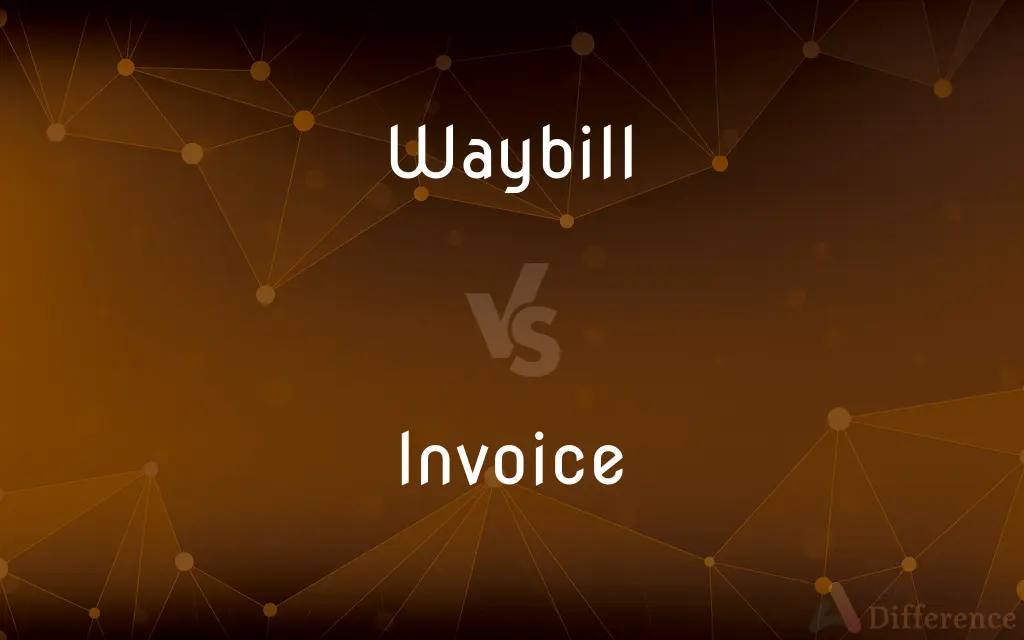Waybill vs. Invoice — What's the Difference?
By Urooj Arif & Maham Liaqat — Updated on March 12, 2024
A waybill is a document issued by a carrier detailing the route and specifics of a shipment, while an invoice is a financial document requesting payment for goods or services provided.

Difference Between Waybill and Invoice
Table of Contents
ADVERTISEMENT
Key Differences
A waybill, often used in the context of shipping and logistics, is a document provided by carriers that outlines the specifics of a shipment, including the origin, destination, and details about the items being shipped. It serves as a guide for the transport of goods, ensuring that they reach their intended destination. On the other hand, an invoice is a financial document issued by a seller to a buyer, detailing the goods or services provided and the amount due. It serves as a formal request for payment, outlining the terms of sale, including prices, quantities, and payment terms.
While a waybill is primarily concerned with the logistical aspects of a shipment, ensuring the proper transportation and delivery of goods, an invoice focuses on the financial transaction between the buyer and the seller, establishing an obligation for payment. Waybills are used by various parties in the shipping and logistics chain to track and manage shipments, whereas invoices are used within the financial processes of businesses to manage accounts receivable and payable.
The information on a waybill is essential for carriers and logistics providers to process and handle shipments efficiently. It typically includes a tracking number, shipment date, detailed description of the goods, and the names and addresses of the sender and recipient. In contrast, an invoice provides a breakdown of the costs associated with the purchase, including individual item prices, total amount due, tax information, and payment instructions.
While waybills facilitate the physical movement of goods through the supply chain, invoices facilitate the financial transactions and legal obligations related to the sale of goods and services. Both documents play critical roles in international trade and logistics, ensuring the smooth flow of goods and financial transactions across borders.
Despite their differences, waybills and invoices may sometimes be used in conjunction to provide a comprehensive overview of a transaction, including both the shipment details and the financial aspects. This dual use ensures clarity and accountability in the movement and sale of goods, supporting efficient business operations and compliance with regulatory requirements.
ADVERTISEMENT
Comparison Chart
Purpose
Details the route and specifics of a shipment.
Requests payment for goods or services provided.
Primary Use
Shipping and logistics, tracking shipments.
Financial transactions, record-keeping.
Information Included
Origin, destination, item details, tracking number.
Prices, quantities, total amount due, payment terms.
Role in Transaction
Facilitates the physical movement of goods.
Establishes financial obligations and records sales.
Recipients
Shippers, carriers, and logistics providers.
Buyers, accounting departments, tax authorities.
Compare with Definitions
Waybill
Used by carriers and shippers.
Logistics companies rely on waybills to manage their deliveries.
Invoice
Requests payment from the buyer.
The invoice listed 30-day payment terms for the equipment purchased.
Waybill
A document for shipping details, not prices.
The courier provided a waybill for tracking the package.
Invoice
A bill for goods or services.
The vendor sent an invoice for the completed web design project.
Waybill
Includes tracking and item specifics.
The waybill listed the contents and their quantities for customs.
Invoice
Essential for managing accounts receivable.
The business tracked payments using the issued invoices.
Waybill
Essential for routing and delivery.
The waybill ensured the shipment reached its destination efficiently.
Invoice
Includes itemized costs and totals.
The invoice broke down the costs for materials and labor.
Waybill
Facilitates shipment handling.
The warehouse used the waybill to prepare the order for dispatch.
Invoice
Used for financial record-keeping.
The accountant filed the invoice for year-end tax preparation.
Waybill
A waybill (UIC) is a document issued by a carrier giving details and instructions relating to the shipment of a consignment of goods. Typically it will show the names of the consignor and consignee, the point of origin of the consignment, its destination, and route.
Invoice
An invoice, bill or tab is a commercial document issued by a seller to a buyer, relating to a sale transaction and indicating the products, quantities, and agreed prices for products or services the seller had provided the buyer. Payment terms are usually stated on the invoice.
Waybill
A document giving details and instructions relating to a shipment of goods.
Invoice
A detailed list of goods shipped or services rendered, with an account of all costs; an itemized bill.
Waybill
A document that lists the final destination (and other details) of each part of a cargo.
Invoice
The goods or services itemized in an invoice.
Waybill
To provide (cargo) with a waybill document.
Invoice
To make an invoice of (goods or services).
Waybill
A list of passengers in a public vehicle, or of the baggage or gods transported by a common carrier on a land route. When the goods are transported by water, the list is called a bill of lading.
Invoice
To send an invoice to; bill.
Waybill
A receipt given by the carrier to the shipper acknowledging receipt of the goods being shipped and specifying the terms of delivery
Invoice
A bill; a commercial document issued by a seller to a buyer indicating the products, quantities and agreed prices for products or services that the seller has already provided the buyer with. An invoice indicates that, unless paid in advance, payment is due by the buyer to the seller, according to the agreed terms.
Invoice
The lot or set of goods as shipped or received.
The merchant receives a large invoice of goods.
Invoice
The price which a seller or dealer pays the manufacturer for goods to be sold.
Invoice
(transitive) To bill; to issue an invoice to.
I will invoice my supplier tomorrow.
Invoice
(transitive) To make an invoice for (goods or services).
Invoice
A written account of the particulars of merchandise shipped or sent to a purchaser, consignee, factor, etc., with the value or prices and charges annexed.
Invoice
The lot or set of goods as shipped or received; as, the merchant receives a large invoice of goods.
Invoice
To make a written list or account of, as goods to be sent to a consignee; to insert in a priced list; to write or enter in an invoice.
Goods, wares, and merchandise imported from Norway, and invoiced in the current dollar of Norway.
Invoice
An itemized statement of money owed for goods shipped or services rendered;
He paid his bill and left
Send me an account of what I owe
Invoice
Send an bill to;
She invoiced the company for her expenses
Common Curiosities
What is an invoice?
An invoice is a financial document issued by a seller to a buyer, detailing the goods or services provided and the amount owed, serving as a formal request for payment.
Why is an invoice important for businesses?
Invoices are crucial for businesses as they formalize the request for payment, facilitate financial record-keeping, and are essential for managing accounts receivable.
How do waybills and invoices differ in their use?
Waybills are used in shipping and logistics for tracking and managing shipments, while invoices are used in financial transactions to request and record payments.
Can a waybill include pricing information like an invoice?
Typically, a waybill does not include pricing information; it focuses on shipment details. Pricing information is reserved for invoices.
What is a waybill?
A waybill is a document issued by a carrier detailing the shipment's route, contents, and delivery instructions, used for tracking and managing shipments.
How do businesses use invoices and waybills together?
Businesses may use invoices and waybills together to ensure both the financial and logistical aspects of a transaction are documented, facilitating smooth operations and compliance.
How do small businesses manage waybills and invoices?
Small businesses may use software systems or manual methods to manage waybills and invoices, ensuring accurate tracking of shipments and financial transactions.
Is a waybill legally binding like an invoice?
A waybill is not a financial obligation but a contractual document between the shipper and carrier for transportation services, whereas an invoice is a legally binding request for payment.
Are digital waybills and invoices commonly used?
Yes, digital versions of waybills and invoices are increasingly common, offering efficiency, faster processing, and environmental benefits over traditional paper documents.
What role does an invoice play in tax preparation?
Invoices serve as official records of sales and purchases, providing the necessary details for tax reporting and preparation, including taxable transactions and applicable deductions.
What information is crucial on a waybill for customs clearance?
For customs clearance, a waybill must accurately list the shipment's contents, value (for insurance purposes), origin, and destination.
How does a waybill facilitate international shipping?
A waybill provides detailed information about a shipment's route, contents, and delivery instructions, crucial for customs clearance and efficient delivery in international shipping.
How do waybills contribute to supply chain management?
Waybills contribute to supply chain management by providing essential information for tracking, routing, and delivering shipments, ensuring efficient logistics operations.
Can an individual receive a waybill or invoice?
Yes, individuals can receive waybills when involved in shipping goods and invoices for personal purchases or services rendered.
What happens if there are discrepancies between a waybill and an invoice?
Discrepancies between a waybill and an invoice can lead to delivery delays, customs hold-ups, or payment disputes, requiring prompt resolution for smooth transaction completion.
Share Your Discovery

Previous Comparison
Soul vs. Soulless
Next Comparison
Buckskin vs. DeerskinAuthor Spotlight
Written by
Urooj ArifUrooj is a skilled content writer at Ask Difference, known for her exceptional ability to simplify complex topics into engaging and informative content. With a passion for research and a flair for clear, concise writing, she consistently delivers articles that resonate with our diverse audience.
Co-written by
Maham Liaqat













































